Two New Ions: ASUS AT3N7A-I and ASRock Ion 330
by Anand Lal Shimpi on August 28, 2009 12:00 AM EST- Posted in
- Motherboards
Sidebar: ASRock Ion 330
Although today is all about ASUS’ entry into the Ion world with the AT3N7A-I, it’s also about picking your perfect Ion platform. I decided to round up the three Ion boards/systems currently on the market and compare them all as we evaluate the ASUS.
The Zotac Ion you already know about, we’ve covered it extensively and more recently looked at its latest PCB revision. The Ion platform you haven’t seen on AnandTech is ASRock’s Ion 330.
Unlike the ASUS and Zotac solutions, the ASRock Ion 330 is a complete system. For $379.99 you get a mini-ITX case, power supply, 2GB of memory, DVD drive and a 320GB hard drive - in addition to the ASRock Ion board. To give you an idea of scale I set the ASRock Ion 330 next to a standard 3.5” hard drive:

So, so sweet and small.
On the back of the ASRock Ion you get a healthy serving of 6 USB ports, VGA out, HDMI out, an Ethernet jack, three 1/8” audio jacks and optical audio out. There’s also a connector for the external 65W DC power supply. Despite this being 2009, there are no ports on the front of the chassis; it does keep things clean, but slightly inconvenient at the same time.
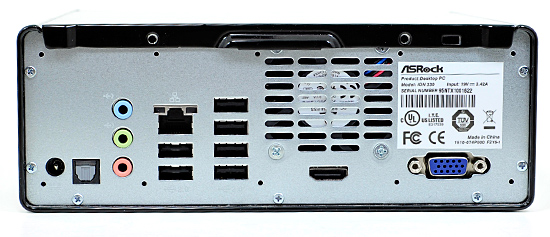
Inside there’s not much to see at first glance. Two screws hold the top cover on, removing them and sliding the cover back reveals the removable carrier that holds the slimline DVD drive and 2.5” HDD:
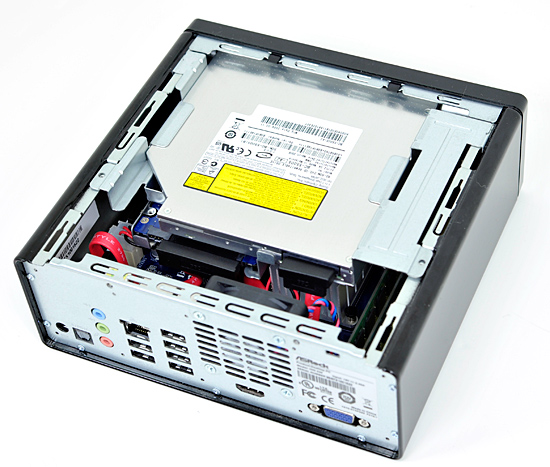
ASRock sent us the significantly more baller Ion 330-BD model, which forgoes the DVD drive for a slimline Blu-ray drive. The impact on price shouldn’t go unnoticed as the drive costs around $200 more than the standard DVD drive.
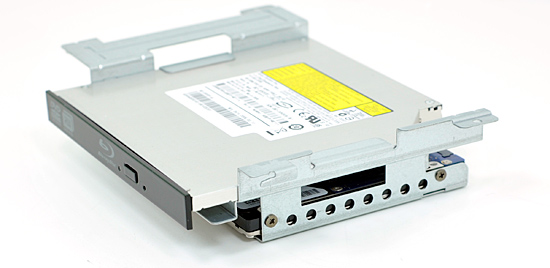
The slimline drive uses a mini-SATA power connector instead of standard SATA power. It’s supplied power somewhat crudely by a 4-pin 5V header on the motherboard that splits off and feeds both the optical drive and HDD.
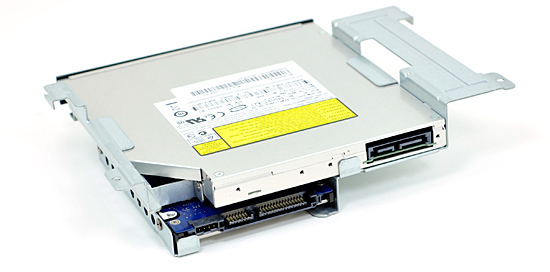
The hard drive is a standard 2.5” notebook drive. In this case it’s a 320GB Seagate Momentus 5400.6.
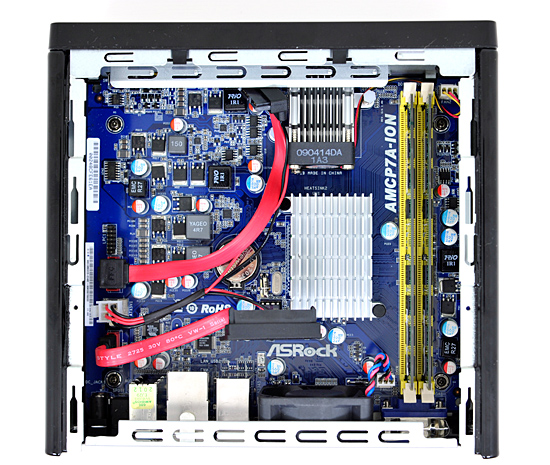
Below the drive carrier lies the motherboard itself and its two-fan cooling solution. A very small fan up front keeps the Atom processor cool. A larger fan in the back moves air around the rest of the chassis. The NVIDIA GPU doesn’t have a fan directly mounted to its heatsink and instead relies on the two fans to move heat off of its fins.
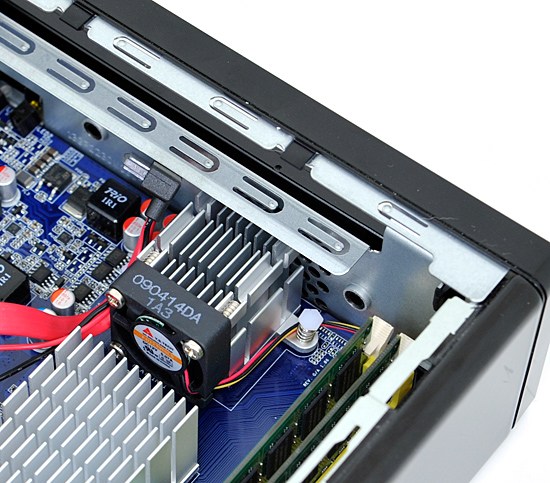
The smaller, and quieter CPU fan

The larger, and louder chassis fan
I hate to spoil the surprise, but the ASRock Ion 330 is built off of the same hardware as the ASUS and Zotac boards. You get a 1.6GHz dual-core Atom 330 combined with a NVIDIA GeForce 9300/9400M chipset. The result? Nearly identical performance.
The ASRock is nice from a convenience standpoint, all you do is buy the machine and load an OS on it. The major issues with it are a fan that isn’t silent (more on this later), and the fact that if you want to use an SSD in the machine you’re out $70 since it comes with a non-optional 2.5” HDD.










61 Comments
View All Comments
jwinckelmann - Sunday, September 13, 2009 - link
Hi,at least here in Germany the AT3N7A-I is officially sold with the noisy 6000 RPM fan. Totally unacceptable...
Bye,
Jan
nachtgeist - Sunday, September 6, 2009 - link
Very usefull rewiev, but i don't understand where is diffenrent between Asus and Zotac board for the 20% power consum diffenrent.Asus Express gate looks very good. But the power consum and noise fan is terrible.
When is poblem? Same CPU, same Chipsets and Asus takes 19W(?) more.
Abby - Wednesday, September 2, 2009 - link
A thousand Thaanks on effort writing this article and all the troubleshooting and also all the great help on sending bck faulty reports on behalf of us.Your enthusiasm on technology and service were greatly appreciated.
Thanks again.
best regards,
Abby
THG S**Ks hard~!
Shadowmaster625 - Tuesday, September 1, 2009 - link
Why not just use a celeron E1400 for $40, and maybe even overclock it?And yes, I would still trust my $50 ebay P4 865g system over one of these things. 166MHz FSB isnt just stupid, its like a sick joke.
deegee - Tuesday, September 1, 2009 - link
> Why not just use a celeron E1400The Atom CPU's lower power is the point of these.
You can also purchase the ITX boards with socket LGA775 or AM2 if you want a faster processor, but at a major increase in power use.
> I would still trust my $50 ebay P4
Trust? These are the same components as found on ATX boards, just a smaller form factor at 17cm x 17cm. ITX is designed for smaller size and lower power. Compare it to like buying a Mac Mini.
> 166MHz FSB
The Atom units are 533 FSB. Look at the "Rated FSB" value on CPUZ. The Bus Speed will be 1/2 for a two-way and 1/4 for a 4-way interleaved memory system. The regular ATX systems are the same for their FSB. You may wish to dl a copy of CPUZ and run it on your own system to see what the numbers mean.
deegee - Tuesday, September 1, 2009 - link
Sorry, fingers working faster than brain and no post edit... :-)DDR = double data rate, so 133 clock = 266 DDR freq, 2x interleave = 533 FSB, if I recall.
deegee - Tuesday, September 1, 2009 - link
I've been using an Atom PC for my surfing system for quite some time now. It has the Intel 945GCLF2D, 2GB RAM, Kingston 64GB SSDnow, in an Apex MI-008 case. On sale all the parts cost me about $300CDN. The case is 8.5"W x 12.5"D x 5"H (just slightly larger than an APC ES750W brick UPS), supports 2x 3.5" and 1x 5.25", and includes a 250W internal PS. It would work for a HS or HTPC since you could fit an SSD OS drive, a 1-2TB HD, and a DVD.I pulled the noisy fan off of the mobo and put a Noctua 80mm fan with the silencer connector (970RPM) blowing across the board from case vent-to-vent. It's so quiet you can hardly tell the system is on (it's half as loud as just a 3.5" HD's noise). The CPU runs at 25C, mobo at 40C. Temps go up by only ~5C under full load in Everest etc.
I'm running Windows 7RC and Kubuntu on it. Ubuntu (Gnome) is just too slow on the video. KDE performs not bad. But W7RC in Aero performs well, even on the GMA950. It is not as fast as my C2D or C2Q workstations of course, but it does ok for surfing. I also have a HS and HTPC but both of those are using C2D ATX, I personally wouldn't use an Atom for those since I prefer more performance, but for general surfing and a low-power system that I can leave on for downloading I don't care.
I'll probably upgrade the mobo sometime in the future to get the better video. I really recommend the small size and low noise of the Atom.
lordmetroid - Monday, August 31, 2009 - link
I want to build a server/HTPC combo, thing is it will have to be in my home and I can't get proper rest with a fan humming in the background.I was thinking, would it be possible to build a completely fanless system using the IONITX-C-U? Using an SSD and the external power brick would give me a system without any moving parts. But what kind of temperatures would such a system generate?
snarfies - Monday, August 31, 2009 - link
Asus and Asrock have repeated the exact same mistake that prevented me from considering the Zotac - Only three drive connectors. My MiniITX file server requires four: One for the SD Card reader, one for the optical drive, and two for the RAID1. The only Ion-based board that I know to support four drives is the Point of View Ion 330.strikeback03 - Monday, August 31, 2009 - link
There are USB headers that can be used for a card reader